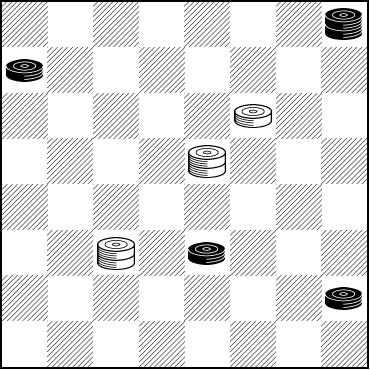Barker's Triangle

In our modern day, a certain Jack Barker has written a book about "The Conjoined Triangles of Success" which supposedly will guide you to running a startup company that thrives. Engineering and Manufacturing meet Sales and Growth along the hypotenuse of Compromise.
We can't really speak to this methodology, but there is another Barker and another triangle that predates the modern interpretation by over 100 years. It's a study by the famed checkerist C. F. Barker, and his position, shown below, is often known as Barker's Triangle.

WHITE
White to Play and Draw
W:W11,K15,K22:BK4,5,23,28
We've got to say this problem is one of the most instructive we've ever come across. Why it's called a 'triangle' will become clear when you find the solution. So, give it a good effort and then triangulate your mouse on Read More to see how it's done.![]()
Solution
We've published the "original" solution, with some extensions; variations are surely possible.
22-17 28-32---A 15-19 23-26 17-14 32-27 19-16 27-23 16-12 26-30 11-7 30-25 7-2 25-22---B 2-6 22-18 6-9 18-15 9-6 23-19 6-2 15-11 12-8 19-15 8-12 Drawn---C
A---5-9 17-13 9-14 15-10 Drawn.
B---25-21 2-6 23-26 6-10 and the draw is similar to the main line of play.
C---Black can make no progress. The man on 5 can't advance; the White king on 2 prevents Black from driving away the White king on 14; and the Black king on 4 can't get into the action. Here's one try that doesn't work: 15-19 12-8 11-15 8-12 19-23 2-6 15-18 6-9 etc. The piece on 5 just can't go forward and the King on 4 stays stuck. At this point the computer suggests that Black just give up the attempt with 23-27 14x32 5x14 32-27 14-18 Drawn. Of course no human would ever play that way!
This problem demonstrates a great use by White of minimal forces. Every piece plays a critical role in holding off the superior Black army.
You can email the Webmaster with comments on this article.